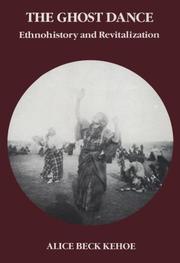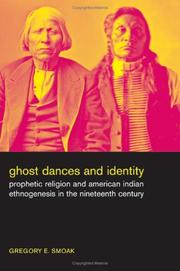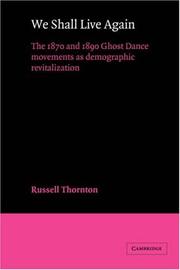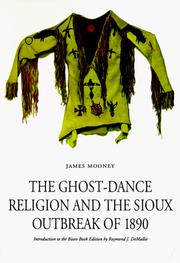| Listing 1 - 10 of 16 | << page >> |
Sort by
|
Book
Year: 2012 Publisher: Shanghai : 國立臺灣師範大學出版中心,
Abstract | Keywords | Export | Availability | Bookmark
 Loading...
Loading...Choose an application
- Reference Manager
- EndNote
- RefWorks (Direct export to RefWorks)
Book
Year: 2012 Publisher: Shanghai : 國立臺灣師範大學出版中心,
Abstract | Keywords | Export | Availability | Bookmark
 Loading...
Loading...Choose an application
- Reference Manager
- EndNote
- RefWorks (Direct export to RefWorks)
Book
Year: 1965 Publisher: London : University of Chicago Press,
Abstract | Keywords | Export | Availability | Bookmark
 Loading...
Loading...Choose an application
- Reference Manager
- EndNote
- RefWorks (Direct export to RefWorks)

ISBN: 0030028523 Year: 1989 Publisher: New York (N.Y.) : Holt, Rinehart and Winston,
Abstract | Keywords | Export | Availability | Bookmark
 Loading...
Loading...Choose an application
- Reference Manager
- EndNote
- RefWorks (Direct export to RefWorks)
Ghost dance. --- Indian dance --- Indians of North America --- Nativistic movements --- Religion.
Book
ISBN: 0803293801 Year: 1975 Publisher: Lincoln ; London : University of Nebraska Press,
Abstract | Keywords | Export | Availability | Bookmark
 Loading...
Loading...Choose an application
- Reference Manager
- EndNote
- RefWorks (Direct export to RefWorks)
The last significant clash of arms in the American Indian Wars took place on December 29, 1890, on the banks of Wounded Knee Creek in South Dakota. Of the 350 Teton Sioux Indians there, two-thirds were women and children. When the smoke cleared, 84 men and 62 women and children lay dead, their bodies scattered along a stretch of more than a mile where they had been trying to flee. Of some 500 soldiers and scouts, about 30 were dead-some, probably, from their own crossfire. Wounded Knee has excited contradictory accounts and heated emotions. To answer whether it was a battle or a massacre,
Wounded Knee Massacre, S.D., 1890. --- Lakota Indians --- Ghost dance. --- History.

ISBN: 1282360582 9786612360589 0520941721 1598758012 9780520941724 1423731379 9781423731375 0520246586 9780520246584 9781598758016 9781282360587 Year: 2006 Publisher: Berkeley University of California Press
Abstract | Keywords | Export | Availability | Bookmark
 Loading...
Loading...Choose an application
- Reference Manager
- EndNote
- RefWorks (Direct export to RefWorks)
This innovative cultural history examines wide-ranging issues of religion, politics, and identity through an analysis of the American Indian Ghost Dance movement and its significance for two little-studied tribes: the Shoshones and Bannocks. The Ghost Dance has become a metaphor for the death of American Indian culture, but as Gregory Smoak argues, it was not the desperate fantasy of a dying people but a powerful expression of a racialized "Indianness." While the Ghost Dance did appeal to supernatural forces to restore power to native peoples, on another level it became a vehicle for the expression of meaningful social identities that crossed ethnic, tribal, and historical boundaries. Looking closely at the Ghost Dances of 1870 and 1890, Smoak constructs a far-reaching, new argument about the formation of ethnic and racial identity among American Indians. He examines the origins of Shoshone and Bannock ethnicity, follows these peoples through a period of declining autonomy vis-a-vis the United States government, and finally puts their experience and the Ghost Dances within the larger context of identity formation and emerging nationalism which marked United States history in the nineteenth century.
Bannock Indians --- Shoshoni Indians --- Ghost dance --- Indians of North America --- Numic Indians --- Shoshone Indians --- Snake Indians --- Shoshonean Indians --- Indian dance --- Nativistic movements --- Ethnic identity. --- Religion. --- Rites and ceremonies. --- History --- 19th century american history. --- 19th century native american history. --- american indian ghost dance movement. --- american indians. --- bannocks. --- cultural studies. --- ethnogenesis. --- ghost dance. --- history. --- identity. --- indigenous cultures. --- indigenous peoples. --- missionary. --- nationalism. --- native american culture. --- native americans. --- native peoples. --- new religion. --- politics. --- prophets. --- race in america. --- religion. --- reservation life. --- shamans. --- shoshones. --- social identity. --- spiritual. --- supernatural forces. --- united states government. --- united states of america.

ISBN: 0521328942 0521034523 0511752733 Year: 1986 Publisher: Cambridge : Cambridge University Press,
Abstract | Keywords | Export | Availability | Bookmark
 Loading...
Loading...Choose an application
- Reference Manager
- EndNote
- RefWorks (Direct export to RefWorks)
This study of the 1870 and 1890 Ghost Dance movements among North American Indians offers an innovative theory about why these movements arose when they did. Emphasizing the demographic situation of American Indians prior to the movements, Professor Thornton argues that the Ghost Dances were deliberate efforts to accomplish a demographic revitalization of American Indians following their virtual collapse. By joining the movements, he contends, tribes sought to assure survival by increasing their numbers through returning the dead to life. Thornton supports this thesis empirically by closely examining the historical context of the two movements and by assessing tribal participation in them, revealing particularly how population size and decline influenced participation among and within American Indian tribes. He also considers American Indian population change after the Ghost Dance periods and shows that participation in the movements actually did lead the way to a demographic recovery for certain tribes.
Social Sciences --- Sociology --- Ghost dance. --- Indians of North America --- American aborigines --- American Indians --- First Nations (North America) --- Indians of the United States --- Indigenous peoples --- Native Americans --- North American Indians --- Indian dance --- Nativistic movements --- Population. --- Rites and ceremonies. --- Culture --- Ethnology
Book
ISBN: 1496205669 1496205642 1496204581 9781496205667 9781496204585 9781496204585 9781496205643 9781496205650 Year: 2018 Publisher: Lincoln University of Nebraska Press
Abstract | Keywords | Export | Availability | Bookmark
 Loading...
Loading...Choose an application
- Reference Manager
- EndNote
- RefWorks (Direct export to RefWorks)
"Framed by theories of syncretism and revitalization, "Religious Revitalization among the Kiowas" examines changes in Kiowa belief and ritual in the final decades of the nineteenth century"--
Peyotism. --- Ghost dance. --- Kiowa Indians --- Cáuigú Indians --- Kiowan Indians --- Indians of North America --- Indian dance --- Nativistic movements --- Peyote cult --- Peyote religion --- Rites and ceremonies --- Religion --- Ethnobotany --- K'oigu Indians --- Kwuda Indians --- T'epda Indians
Book
ISBN: 1281958530 9786611958534 0803220421 9780803220423 9780803210738 0803210736 9781281958532 9780803245914 0803245912 6611958533 1496211073 Year: 2008 Publisher: Lincoln University of Nebraska Press
Abstract | Keywords | Export | Availability | Bookmark
 Loading...
Loading...Choose an application
- Reference Manager
- EndNote
- RefWorks (Direct export to RefWorks)
A broad range of perspectives from Natives and non-Natives makes this book the most complete account and analysis of the Lakota ghost dance ever published. A revitalization movement that swept across Native communities of the West in the late 1880s, the ghost dance took firm hold among the Lakotas, perplexed and alarmed government agents, sparked the intervention of the U.S. Army, and culminated in the massacre of hundreds of Lakota men, women, and children at Wounded Knee in December 1890.
Teton Indians --- Ghost dance --- Indian dance --- Nativistic movements --- Lakota Sioux Indians --- Lakotah Indians --- Prairie dweller Indians --- Sioux Indians, Western --- Teton Sioux Indians --- Thítunwan Indians --- Titunwan Indians --- Western Sioux Indians --- Siouan Indians --- Indians of North America --- Government relations. --- Rites and ceremonies.

ISBN: 0585345643 9780585345642 0803231555 9780803231559 0803281773 9780803281776 Year: 1991 Publisher: [Place of publication not identified] University of Nebraska Press
Abstract | Keywords | Export | Availability | Bookmark
 Loading...
Loading...Choose an application
- Reference Manager
- EndNote
- RefWorks (Direct export to RefWorks)
Ghost dance --- Dakota Indians --- Gender & Ethnic Studies --- Social Sciences --- Ethnic & Race Studies --- Nadowessioux Indians --- Naudowessie Indians --- Nawdowissnee Indians --- Sioux Indians --- Wahpakoota Sioux Indians --- Indians of North America --- Siouan Indians --- Indian dance --- Nativistic movements --- Wars, 1890-1891 --- Dakota Indians. --- Wars, 1890-1891.
| Listing 1 - 10 of 16 | << page >> |
Sort by
|

 Search
Search Feedback
Feedback About UniCat
About UniCat  Help
Help News
News